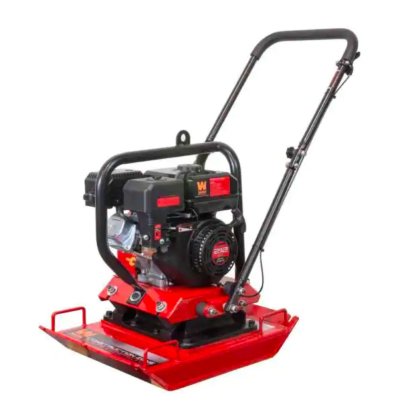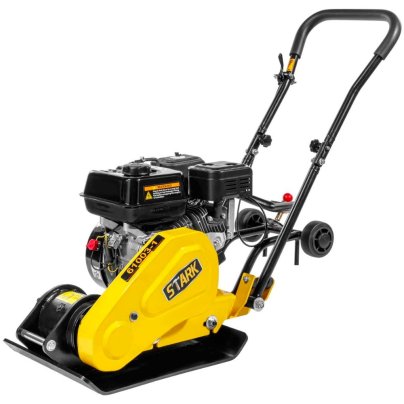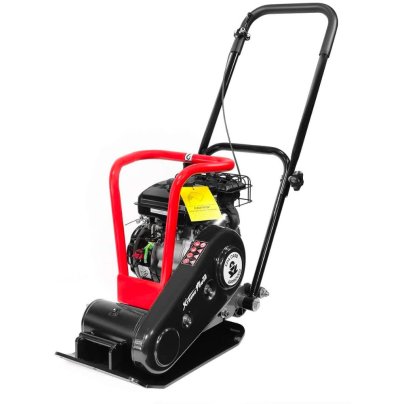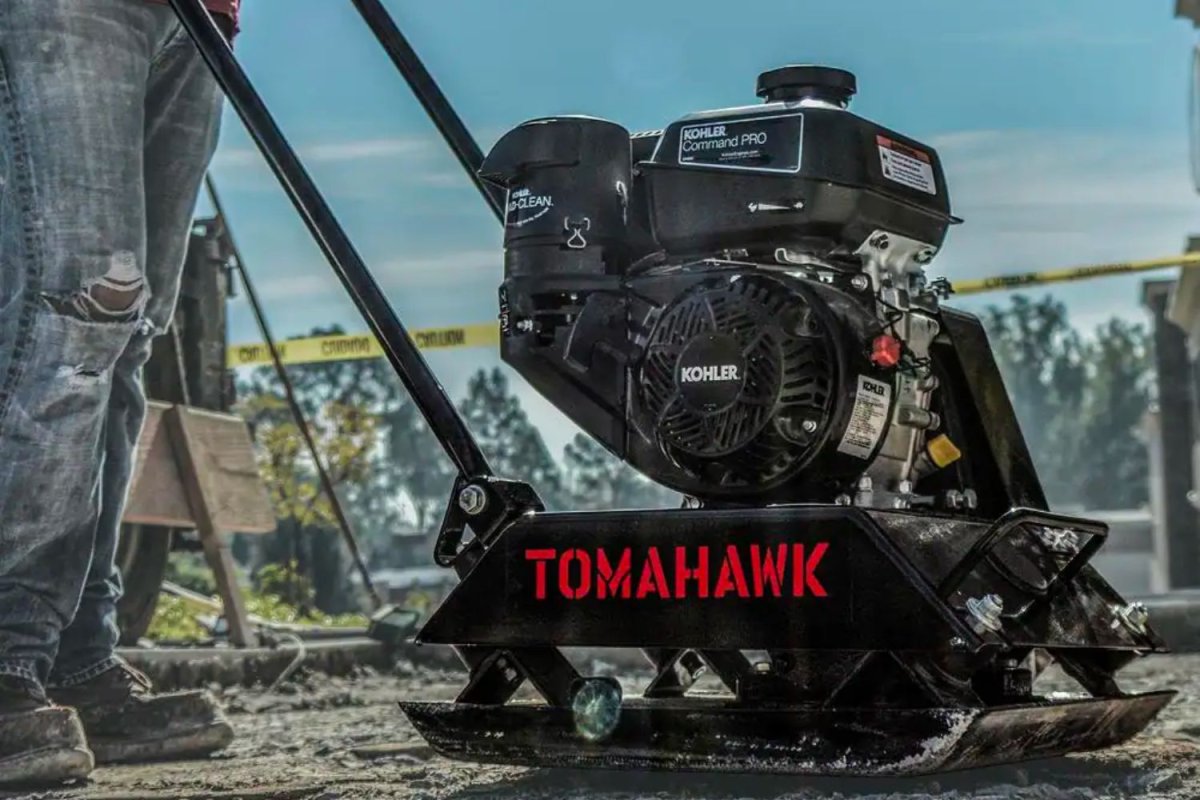
We may earn revenue from the products available on this page and participate in affiliate programs. Learn More ›
Nothing is as effective as a plate compactor when it comes to creating a solid foundation for hardscaping projects like paths, patios, and driveways. These tools are invaluable for creating a stable base from soil, gravel, or sand, and then ensure pavers are properly set. They put a smooth finish on asphalt, and firm up slopes and contours when landscaping.
Plate compactors run the gamut, from small machines for yard use to heavy-duty models for highway construction. While the latter falls beyond the scope of this article, the information below will help both DIY enthusiasts and contractors identify the best plate compactor for their needs.
- BEST OVERALL: WEN 7 HP 4500-Pound Compaction Force Plate Compactor
- BEST BANG FOR THE BUCK: Stark Pro-Series 6.5HP 5500MAX VPM Walk Behind Plate
- BEST LIGHTWEIGHT: XtremepowerUS 61017 Walk Behind Plate Compactor
- BEST FOR SOIL: Tomahawk Power Vibratory Plate Compactor for Soil
- BEST FOR ASPHALT: Multiquip MVC82VHW Honda GX160 Plate Compactor
- BEST MANEUVERABILITY: NorthStar Close-Quarters Plate Compactor -with 5.5 HP
- HONORABLE MENTION: Powerhorse Single-Direction Plate Compactor
- ALSO CONSIDER: BILT HARD Plate Compactor Rammer, 21 x 14.5 inch
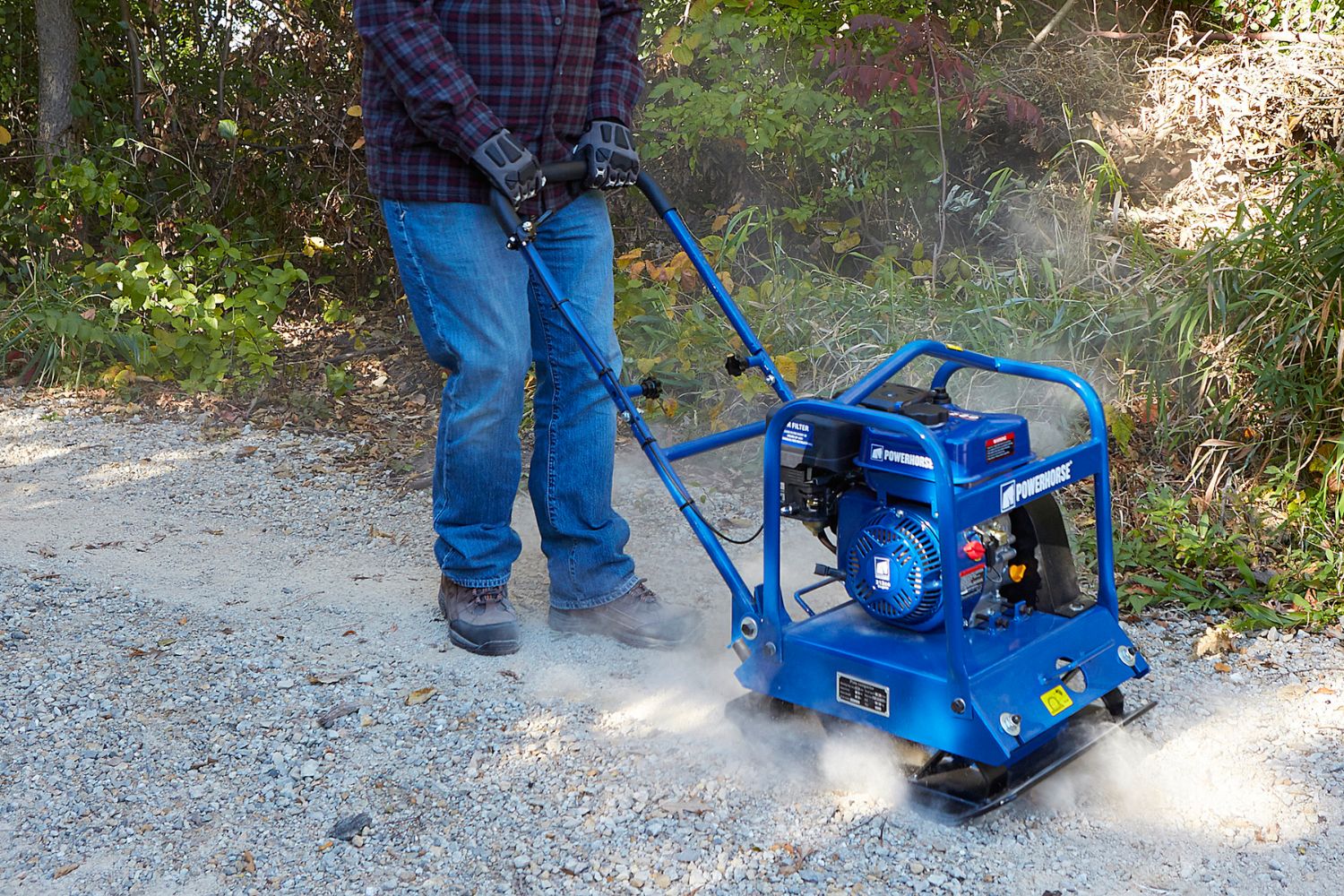
What to Consider When Choosing the Best Plate Compactor
Whether you’re a contractor considering buying a plate compactor for your business or a DIYer looking to rent one for a project, it’s important to understand the various types of devices available, how they work, and what they’re made of.
Types of Plate Compactors
In basic terms, a plate compactor (also known as a wacker plate), is a steel plate with a gasoline or diesel engine mounted to it. A mechanism causes the plate to vibrate rapidly, thus compressing and/or smoothing the material underneath.
Plate compactors fall under two general categories: single or reversible. Most small and mid-size machines are single, which means they move in one direction only. Given their compact size, it is relatively easy to guide them in the required direction.
Reversible plate compactors can move backward or forward. However, these machines can be challenging to control. In fact, some heavy-duty models create such intense vibration that a remote joystick is necessary to maneuver them.
Engine Power and Capacity
Engine capacity is often seen as a measure of plate compactor performance, and generally speaking, more CCs (cubic centimeters) means more power. The models that made our top picks range from 160cc to 260cc.
However, horsepower (HP)—closely related to but different from capacity—is a better representation of the amount of work the machine does. In the case of machines like plate compactors, it is more beneficial to have greater horsepower than higher capacity.
It’s common for plate compactor companies not to make the motors in their products, often buying them from a specialist manufacturer instead. Both Honda and Kohler engines are particularly popular and have an outstanding reputation for reliability.
Compaction Force
Not surprisingly, compaction force is a key figure when assessing the best plate compactor. This refers to the pressure applied to the surface being compacted and has a much greater impact than the machine’s weight.
Even relatively small machines can produce 1,800 pounds of force per square foot (ft2) or more. Heavy-duty commercial models can top 20,000 pounds. However, absolute force isn’t always the best approach. For example, concrete pavers can be damaged if too much force is applied, so it is important to choose a machine that’s appropriate for the surface being compacted.
Vibration frequency, usually measured in VPM (vibrations per minute) or BPM (blows per minute) has a big impact when working with granular soils that contain a lot of sand or gravel. Vibrations help the material settle, and are as important as the actual force applied when it comes to loose materials.
Compaction depth is sometimes given in product descriptions, though it very much depends on the material being compacted so the figure is of limited value.
Plate Material, Size, and Shape
The vibratory plate itself is usually made of steel, though cast iron is also used. Steel is lighter and usually used on smaller machines. It is less expensive, though it is more easily damaged. Cast iron is more durable but it is usually only found on large, powerful commercial models.
A large plate will cover ground more quickly, although drive speed, which is usually given as feet per minute (ft/min.), is also a factor. Conversely, while a smaller plate might take longer to cover a particular area, it is more maneuverable in tight spaces.
Plate edges are usually beveled or rounded to prevent them from digging in and spoiling the flatness of the surface being worked.
Handles
Plate compactor handles are often quite basic, in many ways similar to lawnmower handles. This is where the throttle is usually mounted, and the handle may fold for easier storage.
Most are fitted to the rear of the machine, but some have a more central fixing, which allows the handle to swing over so it can be accessed from either side of the plate compactor. However, it is important to note that a swing-over handle does not indicate that the machine is reversible.
On some of the better vibratory plate compactors, the handle has anti-vibration mountings. These go some way to insulating the user from the machine, making it more comfortable to use, and reducing fatigue when working with the tool for extended periods.
Water Tank and Other Features
- A water tank is a key feature on a plate compactor used for asphalt, which is sticky when hot. The water flows between the plate and the asphalt surface to prevent drag. The flow is not sufficient to adversely affect the asphalt.
- All motors should be EPA (Environmental Protection Agency) compliant in order to comply with emission regulations. Some also reach the more stringent CARB (California Air Resources Board) standard.
- Lifting handles are almost always fitted. Many have wheels too, making it easier to move the plate compactor around when not in use.
- A rubber pad or mat is sometimes fitted to the plate to protect pavers from surface damage. Such a pad usually needs to be purchased separately, and some machines don’t provide the necessary mounting points.
Our Top Picks
Now you’ve had the opportunity to learn some of the key specifications of plate compactors, it’s time to consider some real-world examples. The following selections are what we consider to be the best plate compactors for DIY challenges and light- to medium-duty contractor work.
Best Overall
WEN 7 HP 4500-Pound Compaction Force Plate Compactor

Pros
Cons
Product Specs
- Compaction force: 4,496 pounds
- Horsepower: 7 HP
- Plate size: 24 inches x 17-3/4 inches
It isn’t easy to pick a single best plate compactor, but the popular WEN consistently tops independent reviews for good reason. It is very well made and offers excellent performance.
The powerful and reliable 212cc motor delivers 7 horsepower, and is both EPA and CARB compliant. At 4,496 pounds, the compaction rate is better than anything else in its class, and vibrations come in at a rate of 4,500 VPM. It can also move fast, capable of covering 82 ft/min. The swing-over handle is a useful addition, allowing the tool to be maneuvered from front or back. However, like most small and mid-sized machines, it is only single direction.
There is very little to fault with the WEN plate compactor, but given the price we are surprised it doesn’t have wheels. It does have four handles and a central lifting bar, but it weighs 207 pounds, so loading and unloading it is a two-person job.
Get the WEN 7 HP Compaction Force Plate at The Home Depot.
Best Bang For The Buck
Stark Pro-Series 6.5HP 5500MAX VPM Walk Behind Plate

Pros
Cons
Product Specs
- Compaction force: 2,360 pounds
- Horsepower: 6.5 HP
- Plate size: 20 inches x 14 inches
Stark makes several high-quality plate compactors. This mid-range Pro-Series model comes at a very competitive price, but sacrifices little in terms of performance when compared to more expensive rivals.
The motor is a 196cc, EPA-compliant unit that delivers 6.5 horsepower. The 2,360-pound compaction rate exceeds that of most competitors in this price range, and the machine offers a maximum 5,500 VPM.
There are a couple of minor drawbacks to note, however. At 66 ft/min., it isn’t fast, and there’s nothing to isolate vibrations from the user. Also, while a useful fold-down wheel set is provided, and there are lifting handles, the Stark Pro-Series weighs a substantial 300 pounds.
Get the Stark Pro-Series 6.5HP Plate Compactor on Amazon.
Best Lightweight
XtremepowerUS 61017 Walk Behind Plate Compactor

Pros
Cons
Product Specs
- Compaction force: 1,920 pounds
- Horsepower: 2.5 HP
- Plate size: 18 7/10 inches x 11 8/10 inches
The XtremepowerUS plate compactor has been designed to tackle jobs where a larger model would be impractical or would deliver excess force. The compact 18 7/10-inch x 11 8/10-inch footprint makes it ideal for creating the sub-base and/or setting pavers in narrow paths. Commercial users could find it useful in trenches or wall foundations. It is also very manageable on slopes.
The motor is a fuel-efficient 79cc unit that is EPA and CARB compliant. Despite the modest capacity, it delivers 2.5 horsepower, providing 1,920 pounds of force at 5,250 VPM. It’s also among the faster models at 80 ft/min.
The XtremepowerUS plate compactor only weighs 115 pounds. That and its built-in lifting handles provide excellent portability. However, it would still have been nice to see wheels fitted.
Get the XtremepowerUS Walk Behind Plate Compactor on Amazon or at Walmart.
Best For Soil
Tomahawk Power Vibratory Plate Compactor for Soil

Pros
Cons
Product Specs
- Compaction force: 3,000 pounds
- Horsepower: 6 HP
- Plate size: 21 inches x 17 inches
Tomahawk is one of the market leaders in plate compactors, with a range renowned for quality and durability. This model is a very good all-rounder but is particularly focused on soil compaction.
The superb 260cc Kohler motor meets both EPA and CARB standards, and delivers 6 horsepower. While the 3,000 pounds of force is competitive, it is the exceptionally high 6,400 VPM that sets this machine apart. It makes it particularly effective at compacting granular (loose) soils, and it also performs well with cohesive (clay-type) material. The 21-inch x 17-inch plate and 79 ft/min. speed makes for rapid coverage of large areas, too.
Weight is reasonable at 176 pounds, and both transport wheels and lifting handles are fitted. The Tomahawk is an excellent machine but is also a considerable investment.
Get the Tomahawk Power Plate Compactor at The Home Depot or Walmart.
Best For Asphalt
Multiquip MVC82VHW Honda GX160 Plate Compactor

Pros
Cons
Product Specs
- Compaction force: 3,080 pounds
- Horsepower: 5.5 HP
- Plate size: 22 3/8 inches x 17 3/4 inches
The smooth base on a plate compactor tends to drag across hot asphalt. It can also pick up small pieces and gouge them into the soft surface. The Multiquip’s 11.5-quart water tank offers an effective solution, running a film of water between machine and material. The tank is relatively easy to remove when not required.
A high-quality 160cc Honda motor is fitted, providing 5.5 horsepower of EPA- and CARB-compliant power. Compaction force of 3,080 pounds combined with 5,600 VPM also makes the Multiquip an efficient compactor for gravel, soil, and sand. A plate surface of 22.4 inches x 17.7 inches and a speed of 72 ft/min. offers good productivity.
At 198 pounds (with the tank empty), it is not particularly heavy for a machine of this size, but while there are lifting handles, there are no wheels. Pricing makes this very much a tool aimed at commercial users.
Get the Multiquip Plate Compactor at Acme Tools or on Amazon.
Best Maneuverability
NorthStar Close-Quarters Plate Compactor -with 5.5 HP

Pros
Cons
Product Specs
- Compaction force: 2,270 pounds
- Horsepower: 5.5 HP
- Plate size: 14 3/4 inches x 13 3/16 inches
Powerful plate compactors are usually quite large machines, so using them in small areas can be challenging. The Northstar Close-Quarters plate compactor is specifically designed to provide users with competitive performance in confined spaces.
This machine relies on Honda’s excellent EPA- and CARB-compliant 160cc motor, giving 5.5 horsepower. In this case, it provides 2,270 pounds of force, at 5,700 VPM. While the footprint of 14 3/4 inches x 13 3/16 inches might be small, the NorthStar is capable of 82 ft/min., so ground coverage is rapid.
The NorthStar weighs 172 pounds and has several lifting handles, but no wheels. It could be an ideal tool for work in small yards, but the price will put it beyond the reach of most DIY users.
Get the NorthStar Close-Quarters Plate Compactor on Amazon or at Northern Tool.
Honorable Mention
Powerhorse Single-Direction Plate Compactor

Pros
Cons
Product Specs
- Compaction force: 3,950 pounds
- Horsepower: 7 HP
- Plate size: 21 1/2 inches x 17 7/10 inches
The Powerhorse plate compactor is another very good all-rounder, but it is a little difficult to categorize. It is a well-made machine, with several plate compactor parts designed to improve durability. It is also quite a large and powerful tool, yet remains competitively priced.
The motor is a high-performance, EPA-compliant unit of 212cc that delivers 7 horsepower. The compacting force of 3,950 pounds of force combines with 5,500 VPNs for good multi-surface compaction. At 21 1/2 inches x 17 7/10 inches, the plate is a good size, though a speed of 65 ft/min. is slower than many.
A substantial roll bar protects the engine, which has a sealed belt cover to stop dust and dirt from getting inside. There’s also a low oil shut-off sensor to prevent engine damage. It weighs 198 pounds but does not have wheels.
Get the Powerhorse Single-Direction Plate Compactor on Amazon or at Northern Tool.
Also Consider
BILT HARD Plate Compactor Rammer, 21 x 14.5 inch

Pros
Cons
Product Specs
- Compaction force: 2,500 pounds
- Horsepower: 6.5 HP
- Plate size: 21 inches x 14 1/2 inches
The stand-out feature of the Bilt Hard is the weight, which is a remarkably low 126 pounds. That, and its compact size, make it a highly maneuverable machine. There is also a wheel kit attached, though it seems fussier than necessary, and isn’t built for rough terrain.
The motor has a capacity of 196cc and is EPA compliant. Power of 6.5 horsepower is certainly competitive, though on such a lightweight machine it only produces 2,500 pounds of force. However, it does run at 5,500 VPM, and a fast-paced 82 ft/min. Rubber engine dampers and sprung handles help keep vibration away from the user.
For those who are struggling to decide between renting a compactor or doing a job themselves, the Bilt Hard plate compactor could be a viable option. However, it doesn’t have the same reputation for long-term durability as, for example, the Stark Pro-Series.
Get the Bilt Hard Plate Compactor on Amazon.
Our Verdict
The WEN plate compactor is a robustly built general-purpose tool that delivers solid performance and excellent value. The Stark Pro-Series is ideal for smaller jobs, and comes at a price that will often make it a competitive alternative to renting a plate compactor.
How We Chose the Best Plate Compactors
I have been involved in two extensive house renovations, so while not a full-time professional I do have hands-on experience using a plate compactor. To support my own knowledge, the Bob Vila team conducted extensive research to make sure we were aware of recent developments.
While performance is always a key issue, we were keen to look at models from across the full range of capabilities, not just high-end equipment. The result is a selection that should appeal to home users as well as landscaping and construction professionals.
Although some of the brands chosen may not be widely known, most have a significant market presence and a reputation for durability and reliability. Price was also a factor, and we sought to select machines that offer good value even when the investment is considerable. However, we did stop short of full-on professional machinery that can easily exceed $10,000.
Tips for Using Plate Compactors
Plate compactors need not be difficult to use, but a few tips will help ensure safety and help produce the desired results.
- Read the manual thoroughly so that you understand how the plate compactor operates and how to stop it quickly if necessary.
- Wear ear protection, safety glasses or goggles, gloves, and strong boots during use.
- Take a firm grip when starting the machine. Start on a level surface if practical to prevent it from wandering. Try a small test area to get accustomed to the handling.
- Work from one corner, up and down in straight lines. Then go back to the start and work back and forwards across the area at 90 degrees to the original direction.
FAQs
The sections above provide a wealth of information to help you choose the best plate compactor for a particular project or range of tasks. While many technical questions will have been answered, during our research we found several of a general nature that merit consideration.
Q:What’s a plate compactor used for?
It can be used to compress sub-bases before pavers or stone walkways are laid, and again afterward to ensure the surface is level. A plate compactor can smooth asphalt on driveways, parking lots, and similar surfaces and also compact soil during general landscaping work.
Q. How strong do you need to be to handle a plate compactor?
In use, it is more a question of technique than physical strength. Many people say the sensation is as if the machine floats over the surface. However, all of the plate compactors we looked at weigh at least 100 pounds, so even with wheels they do require some effort to move around.
Q. Do I need any safety gear to operate a plate compactor?
Plate compactors are loud, so ear protection is recommended, as are safety glasses. Gloves and strong work boots are a good idea. In commercial environments, steel-toed boots and a hard hat are often required.
Q:Should I wet gravel before compacting?
You don’t need to, but if it’s very dry a little water can be sprayed over to help keep the dust down. There is no point in soaking it.
Q:How much will pavers sink when compacted?
This depends on the preparation. The usual recommendation is to compact the sub-base, then lay 1 inch of concrete sand as a bed for the pavers, which helps them interlock properly. In this scenario, pavers will then normally sink about 3/8 of an inch when compacted.
Q:Can you use a plate compactor on soil?
Absolutely. They are particularly effective on so-called granular soils that contain small stones, gravel, or sand.
Q:How do you compact a sub-base without a compactor?
You could use a lawn roller or a hand tamper, though it will be very difficult to achieve the same level of compaction you would with a good plate compactor.
Q:What size plate compactor do I need for pavers?
The size of the plate compactor isn’t as important as the force applied. The Interlocking Concrete Pavement Institute (ICPI) recommends that the best plate compactor for pavers should not exceed 5,000 pounds of force, as anything more could damage them. Experts also recommend fixing a mat to the bottom of the plate to protect the paver surface.
